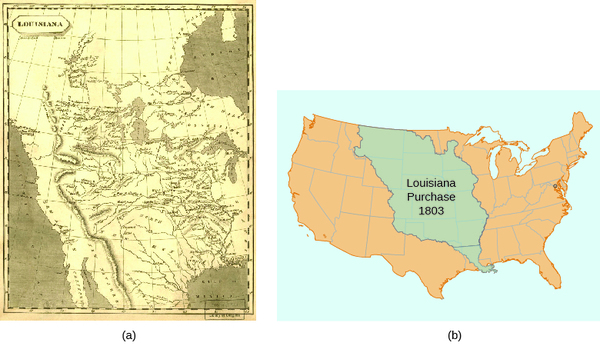| << Chapter < Page | Chapter >> Page > |
The animosity between the political parties exploded into open violence in 1804, when Aaron Burr, Jefferson’s first vice president, and Alexander Hamilton engaged in a duel. When Democratic-Republican Burr lost his bid for the office of governor of New York, he was quick to blame Hamilton, who had long hated him and had done everything in his power to discredit him. On July 11, the two antagonists met in Weehawken, New Jersey, to exchange bullets in a duel in which Burr shot and mortally wounded Hamilton.
Jefferson, who wanted to expand the United States to bring about his “empire of liberty,” realized his greatest triumph in 1803 when the United States bought the Louisiana territory from France. For $15 million—a bargain price, considering the amount of land involved—the United States doubled in size. Perhaps the greatest real estate deal in American history, the Louisiana Purchase greatly enhanced the Jeffersonian vision of the United States as an agrarian republic in which yeomen farmers worked the land. Jefferson also wanted to bolster trade in the West, seeing the port of New Orleans and the Mississippi River (then the western boundary of the United States) as crucial to American agricultural commerce. In his mind, farmers would send their produce down the Mississippi River to New Orleans, where it would be sold to European traders.
The purchase of Louisiana came about largely because of circumstances beyond Jefferson’s control, though he certainly recognized the implications of the transaction. Until 1801, Spain had controlled New Orleans and had given the United States the right to traffic goods in the port without paying customs duties. That year, however, the Spanish had ceded Louisiana (and New Orleans) to France. In 1802, the United States lost its right to deposit goods free in the port, causing outrage among many, some of whom called for war with France.
Jefferson instructed Robert Livingston, the American envoy to France, to secure access to New Orleans, sending James Monroe to France to add additional pressure. The timing proved advantageous. Because black slaves in the French colony of Haiti had successfully overthrown the brutal plantation regime, Napoleon could no longer hope to restore the empire lost with France’s defeat in the French and Indian War (1754–1763). His vision of Louisiana and the Mississippi Valley as the source for food for Haiti, the most profitable sugar island in the world, had failed. The emperor therefore agreed to the sale in early 1803.
Explore the collected maps and documents relating to the Louisiana Purchase and its history at the Library of Congress site.
The true extent of the United States’ new territory remained unknown ( [link] ). Would it provide the long-sought quick access to Asian markets? Geographical knowledge was limited; indeed, no one knew precisely what lay to the west or how long it took to travel from the Mississippi to the Pacific. Jefferson selected two fellow Virginians, Meriwether Lewis and William Clark, to lead an expedition to the new western lands. Their purpose was to discover the commercial possibilities of the new land and, most importantly, potential trade routes. From 1804 to 1806, Lewis and Clark traversed the West.

The Louisiana Purchase helped Jefferson win reelection in 1804 by a landslide. Of 176 electoral votes cast, all but 14 were in his favor. The great expansion of the United States did have its critics, however, especially northerners who feared the addition of more slave states and a corresponding lack of representation of their interests in the North. And under a strict interpretation of the Constitution, it remained unclear whether the president had the power to add territory in this fashion. But the vast majority of citizens cheered the increase in the size of the republic. For slaveholders, new western lands would be a boon; for slaves, the Louisiana Purchase threatened to entrench their suffering further.
Partisan politics dominated the American political scene at the close of the eighteenth century. The Federalists’ and Democratic-Republicans’ views of the role of government were in direct opposition to each other, and the close elections of 1796 and 1801 show how the nation grappled with these opposing visions. The high tide of the Federalist Party came after the election of 1796, when the United States engaged in the Quasi-War with France. The issues arising from the Quasi-War gave Adams and the Federalists license to expand the powers of the federal government. However, the tide turned with the close election of 1800, when Jefferson began an administration based on Democratic-Republican ideals. A major success of Jefferson’s administration was the Louisiana Purchase of 1803, which helped to fulfill his vision of the United States as an agrarian republic.

Notification Switch
Would you like to follow the 'U.s. history' conversation and receive update notifications?